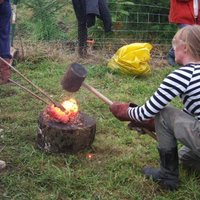Papers by Therese Kearns
Historic England Research Reports, 2023
The Research Report Series incorporates reports by Historic England's expert teams, their predece... more The Research Report Series incorporates reports by Historic England's expert teams, their predecessors and other researchers. Many Research Reports are interim, to make available the results of specialist investigations in advance of full publication. Although subject to internal quality assurance, they are not usually refereed externally and their conclusions may sometimes have to be modified in the light of information not available at the time of the investigation. Where no final project report is available, readers should consult the author before citing these reports.
Journal of Archaeological Science, 2015
A collection of tesserae and two fragments from rounded cakes of coloured glass, probably dating ... more A collection of tesserae and two fragments from rounded cakes of coloured glass, probably dating to the 2nd century AD, were found at West Clacton Reservoir, Essex, in the UK, by Colchester Archaeological Trust. A selection of the finds were analysed using SEM-EDS and ICP-MS. This paper provides data on the composition of the different glass colours and discusses how each colour was made. Colourants and opacifiers were added to a base glass, most often one of the transparent, naturally coloured (blue-green) natron glass types widely available at the time, but there appear to be preferences in the type of base glass used for certain colours, which affects the type of antimonate opacifier precipitated. Possible reasons for using different types of base glass to make strongly coloured Roman glass are discussed.
A collection of tesserae and two fragments from rounded cakes of coloured glass, probably dating ... more A collection of tesserae and two fragments from rounded cakes of coloured glass, probably dating to the 2nd century AD, were found at West Clacton Reservoir, Essex, in the UK, by Colchester Archaeological Trust. A selection of the finds were analysed using SEM-EDS and ICP-MS. This paper provides data on the composition of the different glass colours and discusses how each colour was made. Colourants and opacifiers were added to a base glass, most often one of the transparent, naturally coloured (blue-green) natron glass types widely available at the time, but there appear to be preferences in the type of base glass used for certain colours, which affects the type of antimonate opacifier precipitated. Possible reasons for using different types of base glass to make strongly coloured Roman glass are discussed.
Historical Metallurgy, 2010
ABSTRACT: Archaeological moulds are often analysed for metal traces to identify the alloys cast i... more ABSTRACT: Archaeological moulds are often analysed for metal traces to identify the alloys cast in them. However, the relationships between an alloy and its corresponding trace on a mould are not simple, and few studies have investigated them. This paper reports experiments in which copper alloys of known compositions were cast in clay moulds. The moulds were analysed using energy-dispersive X-ray fluorescence to determine the remains different alloys left in them. Some metal oxides mechanically adhere to the mould, but their ...
This report investigates a range of copper smelting remains which are derived from known technolo... more This report investigates a range of copper smelting remains which are derived from known technologies in use during the Post-Medieval and Modern periods. The material was investigated in an attempt to establish criteria for the identification of similar remains from the archaeological record.

Two cakes of coloured glass and a selection of coloured glass tesserae were recovered from a site... more Two cakes of coloured glass and a selection of coloured glass tesserae were recovered from a site at West Clacton Reservoir, Dead Lane, Great Bentley, Essex. This coloured glass probably dates to between the mid-1st and mid-2nd centuries AD but analysis shows that it comes from a number of sources. The coloured glass was made by adding colourants and opacifiers to a transparent base glass. In most cases the base glass was a type of natron glass with a weak blue-green tint, also known as 'self-coloured'. This glass was widely available in the Roman world since it was used for vessels, such as tableware and bottles. The colours were produced using a variety of metallic ores in various combinations, which were mixed and pre-heated to make a colouring substance or 'corpo' that was then added to the base glass. The red glass and some of the green glass was made using a plant ash base glass.
A number of used and unused crucibles were recovered from the vicinity of a 16thcentury furnace l... more A number of used and unused crucibles were recovered from the vicinity of a 16thcentury furnace located at Legge's Mount, the Tower of London. A crucible typology based upon form was established for the assemblage that illustrates the range of crucibles in use at the site. The crucible fabrics were examined using a combination of macroscopic, chemical and petrographic analyses, the results of which demonstrate the crucibles were manufactured from different clays that were either grog-tempered or quartz-tempered. Crucible use was investigated using a combination of X-ray fluorescence and energy dispersive-scanning electron microscopy. The results show that they were used for processing base metals and precious metals, while some unusual alloy types were detected.
Copper and its alloys by Therese Kearns

"Archaeological moulds are often analysed for metal traces to identify the alloys cast in them. H... more "Archaeological moulds are often analysed for metal traces to identify the alloys cast in them. However, the relationships between an alloy and its corresponding trace on a mould are not simple, and few studies have investigated them. This paper reports experiments in which copper alloys of known compositions were cast in clay moulds. The moulds were analysed using energy-dispersive X-ray fluorescence to determine the remains different alloys left in them. Some metal oxides mechanically adhere to the mould, but their different thermochemical properties ultimately determine the extent to which they become chemically bonded to the fabric. The metals behave differently in the presence of one another, determining which of the constituents of particular alloys leave traces. Inferences can be made as to the original alloys cast in moulds, but any conclusions should be drawn with caution.
"
Peer Reviewed Articles by Therese Kearns
British Archaeology, 2021










Uploads
Papers by Therese Kearns
Copper and its alloys by Therese Kearns
"
Peer Reviewed Articles by Therese Kearns
"